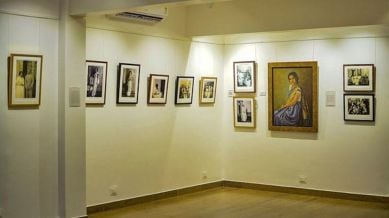Stay updated with the latest - Click here to follow us on Instagram
Raja Ravi Varma’s unseen work on granddaughter Maharani Sethu Lakshmi on display in Bengaluru
The highlight of the exhibition ‘Daughter of Providence’ at the Raja Ravi Varma Heritage Foundation is an oil painting by Ravi Varma of Sethu Lakshmi Bayi, the Regent Queen of Travancore, when she was three years old.

An exhibition featuring a hitherto unseen work of renowned painter Raja Ravi Varma that focuses on the life of his granddaughter Maharani Sethu Lakshmi Bayi, the last ruling queen of erstwhile Travancore kingdom, will be on display in Bengaluru to enthral both art lovers and historians.
The central display of the exhibition titled ‘Daughter of Providence’ at the Raja Ravi Varma Heritage Foundation on Lavelle Road is an undisplayed oil painting by Ravi Varma of Sethu Lakshmi Bayi at the age of three.
monthly limit of free stories.
with an Express account.
Sethu Lakshmi Bayi held the regency of Travancore from 1924 to 1931.
Among the other paintings on display are portraits of the Maharani and her grandfather Raja Ravi Varma, painted by the Queen’s granddaughter Rukmini Varma. Also present are two paintings by Raja Ravi Varma’s son Rama Varma.
Apart from the paintings, the exhibition that will conclude on May 31 is centred around a series of photographs and lithographs depicting Sethu Lakshmi Bayi, her relatives and the people around her at the time, with research and paragraphs explaining the context by writer and historian Manu S Pillai, author of the acclaimed ‘The Ivory Throne’.
The exhibition takes visitors through the various stages of Sethu Lakshmi Bayi’s life – from her childhood, the matrilineal traditions of the Travancore royalty that led to her holding power, and her later life in Bengaluru. Among the photographs and letters are several that display the royal family of Travancore through the eyes of others – the British Viceroy Lord Irwin who wrote a personal letter to her upon acceding to his post, as well as Mahatma Gandhi’s own impressions of her.
According to Archana Shenoy, Director of Curatorial Practices at the Foundation, the painting (of the Maharani, aged three) is based on reference images of two photographs (on display at the exhibition). “He (Ravi Varma) hasn’t made her a smiling girl…she is very serious, because she grew up to be that kind of a woman. A very serious, regal monarch who made a lot of social reforms in Travancore at that time. Even then, they knew she was going to be a future queen.”
She added that there has been no need for restoration or conservation on this work. “It is a little darker as the varnish has become brown with age….it allows the painting to be original as possible. This has luckily been preserved in very good condition,” she mentioned.
Interestingly, the painting of the child queen does not have the signature of Ravi Varma. “Very often we find that when he did paintings of his family members, they are left unsigned…..there are multiple family portraits we have found and 99 per cent are not signed out of respect. For someone unfamiliar with the subject or style, it can be difficult to identify….here because of the existence of the reference photos and who the subject was that we are able to easily identify it. On the other hand if a person brought a painting saying that their grandfather got the painting from someone and they don’t know who the subject is, we could find it harder to attribute,” she explained.
The painting, which has been released for display by the family of the Maharani, will be returned once the exhibition ends.